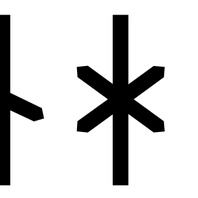
Viking Names
Ragnhild
The female name Ragnhildr is very common throughout the Scandinavian world, including several parts of Britain and Ireland, up to modern times. There is a suggestion that it was restricted to royalty and aristocrats in the Viking Age and then spread to other social groups. It may be the first element of the Lincolnshire place-name Raventhorpe, although in fact the earliest forms suggest the male name Ragnaldr, and more recent publications prefer this interpretation.
Read More
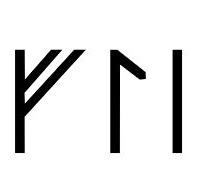
Viking Names
Ulfljot
The Old Norse female personal name Úlfljót is comprised of the element Úlf– ‘wolf’ and the element -ljót which is also attested as the simplex female personal name Ljót. Although Úlfljót is not otherwise attested, the masculine equivalent Úlfljótr is recorded in Iceland and possibly Yorkshire. John Hines has suggested that the female name is inscribed in runes on the Saltfleetby spindle whorl found at Saltfleetby St Clement, Lincolnshire, which he has translated as ‘Óðinn and Heimdallr and Þalfa, they are helping you, Úlfljót…’.
Read More
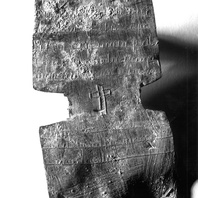
Viking Objects
Inscribed Lead Plaque (LCNCC:1996.64.045)
This lead plaque of uncertain function has a cross incised in its centre and a long Latin text in the Roman alphabet. Like the Saltfleetby spindle whorl, this inscription, too, calls on a divine power, in this case Christ. Between them the two inscriptions represent different responses to literacy and religion in the same time period in neighbouring but probably different communities. (Cumberworth is about 15 miles south of Saltfleetby, in an area with many Scandinavian place-names.) This fragmentary inscription begins with a cross and XPI, the sign for Christ, and after a gap in the text ends with ‘he who by the power of the cross redeemed the world from death, shattered hell or threw open heaven’. The object is dated to the late 10th or 11th century on the basis of the similarity of the writing to contemporary manuscripts.
Read More
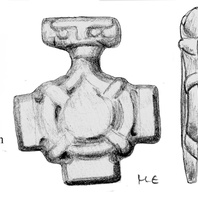
Viking Objects
Die Stamp (NLM-690F57)
This cast copper-alloy die was used in the process of making filigree pendants of the Hiddensee-Rügen type, more specifically, to create pressed silver or gold sheet appliqués, which were applied to a pendant back-plate and used as a base for filigree and granulation work. The ring in the centre creates a closed ring-knot motif related to the Scandinavian Borre style. The Hiddensee-Rügen style is named after the gold jewellery hoard discovered in the late nineteenth century on the island of Hiddensee, off the Baltic coast of Germany. The Swinhope die is one of a small group of recorded objects used in the production of Hiddensee-style cruciform pendants. No finished pendants of the type represented by the Swinhope die are known, either from England or Scandinavia.
Read More
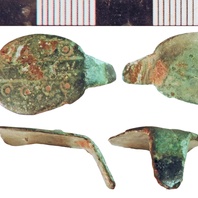
Viking Objects
Copper-Alloy Finger-Ring (NLM-D4A8C9)
A copper-alloy cast finger-ring featuring circular punched ring and dot decoration. Ring and dot was a decorative technique used at various periods from the later Iron Age onwards, but which enjoyed a Viking Age revival.
Read More
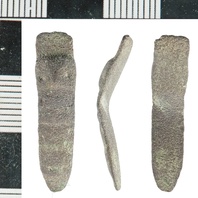
Viking Objects
Copper-Alloy Strap-End (NLM-7415FD)
This copper-alloy strap-end is decorated with vaguely zoomorphic decoration and is possibly a Thomas Class B type 4. The reddish tint of the metal is often characteristic of Anglo-Scandinavian metalwork. Strap-ends came in various styles and were fairly common throughout the Viking world. They were used to decorate the ends of belts and to stop them getting damaged.
Read More
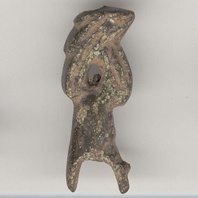
Viking Objects
Prick Spur (LIN-DC6E82)
Early spurs had a neck that ended in a point, called a prick, riveted to the heel band. This object is a fragment of the prick and is cylindrical in section. It is broken at the lowest point where it divides into two arms. There is a hollow shaft above leading into two decorative crescent-shaped arms, one arching over the other. Each arm is longitudinally ribbed. The very top of the object is also pierced, allowing something to pass vertically through the entire object.
Read More
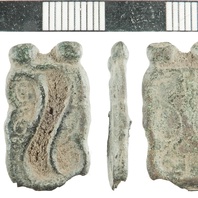
Viking Objects
Strap-End (NLM-E77782)
This copper-alloy strap-end fragment is classified as a Thomas Class B5 type and is decorated with wavy bilateral ornamentation which may show Carolingian influences. Strap-ends came in various styles and were fairly common throughout the Viking world. They were used to decorate the ends of belts and to stop them getting damaged.
Read More
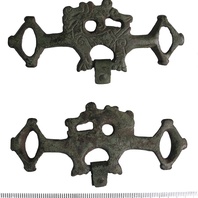
Viking Objects
Harness Fitting (LIN-7C2052)
This is either a harness fitting or strap distributor on which the central part is decorated with Ringerike-style ornament which was used for most of the eleventh century.
Read More
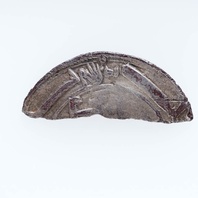
Item
Abbasid Silver Dirham Fragment (CM_1770_2008)
This fragment of a silver dirham was minted for the Abbasid ruler at Madinat al-Salam, [180-183] 796-799 CE . The dirham was a unit of weight used across North Africa, the Middle East, and Persia, with varying values which also referred to the type of coins used in the Middle East during the Viking Age. These coins were extremely prized possessions not only for their silver value but as a way of displaying one’s wealth and vast trade connections. Millions of Arabic Dirhams would have been imported throughout the Viking world and are mostly found in hoards. Arabic dirhams like this one from Torksey demonstrate contact between the Viking diaspora and the Arabic world. Arabic coins are especially useful for dating sites, because they carry the date when they were minted. This permits precise dating where the part of the coin with the date survives, whereas European coins can only be dated to the reign of the ruler depicted on them. In western descriptions of these coins, the Arabic dates found on the coins are usually listed in square brackets, as above, and the European equivalent is listed after it. This coin is a product of the Abbasid Caliphate which was ruled from its capital in Baghdad. The Abbasid Caliphate was at its greatest extent c.850 CE, occupying lands from Morocco in the west to Afghanistan in the east.
Read More
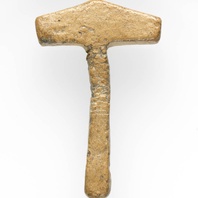
Viking Objects
Lead Thor’s Hammer Pendant (CM_569_2010)
A lead Thor’s hammer pendant with a trapezoidal head and pierced base. These may have been worn to show devotion to the god Thor, or to secure the god’s protection, although there is little evidence to support this interpretation. Pendants like this have been found made of lead, copper alloy, silver and gold, showing that many different strata of society could have worn them. For more information on Scandinavian jewellery in England check out our blog: Brooches, Pendants and Pins: Scandinavian Dress Accessories in England.
